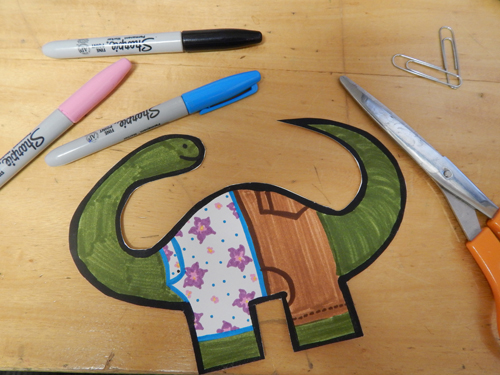 For those of you who have been going to HMNS for years, you may have noticed that we’ve been missing a rather large lady from our Hall of Paleontology. Our Diplodocus, “Dipsy”, was Houston’s first dinosaur unveiled in 1975 and she was de-installed in September 2013. This was her first trip from home for a well-deserved cleaning. Luckily, she’s due back at HMNS in March! We’re so excited for her to be back that we’ve even put her on our overnight shirts! In honor of her return, we’ve dedicated this month’s Educator How-to to this dynamic Diplodocus.
For those of you who have been going to HMNS for years, you may have noticed that we’ve been missing a rather large lady from our Hall of Paleontology. Our Diplodocus, “Dipsy”, was Houston’s first dinosaur unveiled in 1975 and she was de-installed in September 2013. This was her first trip from home for a well-deserved cleaning. Luckily, she’s due back at HMNS in March! We’re so excited for her to be back that we’ve even put her on our overnight shirts! In honor of her return, we’ve dedicated this month’s Educator How-to to this dynamic Diplodocus.
Dipsy can teach us quite a few things about balance! When we first installed Dispy in 1975, she was a tail dragging dino as you can see in the photo below. With further studies, they realized that large dinosaurs like the Diplodocus couldn’t possibly walk with their tail on the ground. Think of all the friction and weight! Instead, they realized that they must have used their tail as a counterbalance for their long neck and head like you can see in the illustration below. To demonstrate how Dipsy uses balance, we are going to make a balancing Dipsy!
How to make your own Balancing Dipsy:
1. Print a copy of Dipsy on cardstock
2. Color your Dipsy (mine’s going on vacation, so I’ve got her wearing a festive Hawaiian shirt)
3. Cut out your Dipsy along the black lines.
4. If you try to balance her now, you may notice that she’s not very good at it. We need to add weight to correct her center of mass.
5. In this case we are going to use paperclips! Add paperclips to Dipsy to get her to balance. Since she is a very large and currently top-heavy dinosaur, we need to add lots of weight down low to keep her balanced. I’ve added three paperclips per foot.
6. If your students would like more of a challenge, have the students adjust the position of the paperclips and watch as her balancing point changes. See if they can get her to balance using different sized paperclips or changing the location of the paperclips.
The point on which something balances is in line with its center of mass. The object will be most stable (and easier to balance) if the center of mass is below the balancing point instead of above it. For regularly shaped objects like a rectangular sheet of paper the center of mass is the geometric center of the object, but it depends on the shape of the object and how the weight is distributed (imagine adding a bunch of paperclips to one side of an index card and then balancing it horizontally on a pencil eraser – the center of mass and the balancing point will be closer to one edge now).
For our Balancing Dipsy, the object is an unusual shape and has unusual weight distribution. We needed to add weights to our Balancing Dipsy to make her center of mass below where we place our finger when she is upright. With enough weight we can get Dipsy to balance on our finger or a pencil!
Dipsy is just one of many dinosaurs that use their tails to balance. On your next field trip to HMNS, you can see several dinosaurs in the Morian Hall of Paleontology that have their tails sticking out for balance. See if you can find them all! While you’re here, you can bring your own Balancing Dipsy to see our very Dipsy the Diplodocus. She’ll be back this March!













